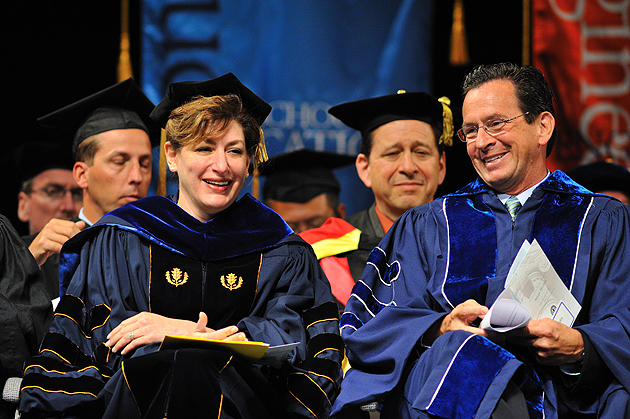Gov. Dannel P. Malloy and UConn President Susan Herbst jointly authored a commentary piece that appeared in Sunday’s edition of The Philadelphia Inquirer about the Bioscience Connecticut initiative and the role it will play in job creation and economic revitalization in Connecticut – and what other states can learn from it.
An Investment that’s Paying Off
The Philadelphia Inquirer, Dec. 4, 2011
Dannel P. Malloy is governor of Connecticut
Susan Herbst is president of the University of Connecticut
Like most other states, Connecticut is grappling with unprecedented fiscal challenges. But compared with the 49 other states, Connecticut is taking a very different approach to the financial crisis: relying on and investing in our public research university to drive the state’s economic revival. And there is tangible evidence this approach is working.
Most states are responding to their sizable budget deficits by slashing spending, laying off employees, and reducing services. In the short term, these steps will produce a balanced budget. But they won’t stimulate economic activity and likely will add to downward-trending economic conditions.
In Connecticut, we are taking a more balanced and strategic approach to our very significant immediate financial and long-term economic challenges. Yes, we prioritized state spending and reduced the state budget substantially. We also made the difficult decision to raise revenue and negotiate historical savings with state employees while avoiding layoffs.
But more than anything else, and like most other states, Connecticut needs new jobs.
So despite the current economic conditions and budgetary limitations, Connecticut made a serious calculation that strategic investments in the University of Connecticut were the most effective way to stimulate immediate and sustained economic activity and grow jobs. How are we doing it?
First, we determined the areas where our state’s commercial and academic strengths aligned with an expanding industry sector. Bioscience was quickly identified as having tremendous growth potential and as an industry with which Connecticut has existing workforce, research, and academic assets. By building upon and investing in the physical and intellectual assets of the UConn Health Center, Connecticut could stimulate immediate and sustained economic activity while improving health-care quality and access.
And UConn was well-poised to lead this undertaking. The state’s 20-year, $2.3 billion investment in the university has dramatically moved UConn into the top echelons of public research universities, as evidenced by the most recent U.S. News & World Report rankings. Based upon UConn’s track record, we were confident that through additional targeted investments, Connecticut would become a global leader in bioscience.
Our plan became reality in the spring, when our state enacted the Bioscience Connecticut initiative, a bold $864 million public-private investment in new and expanded research, educational and clinical facilities, and additional clinician-scientists at the UConn Health Center. Yes, 3,000 construction jobs will be created annually between 2012 and 2018. More important, the combination of additional researchers and state- of-the-art facilities will enable UConn to assemble the critical mass of clinical and scientific personnel needed to double federal and industry research grants and make Connecticut a center for bioscience discovery, innovation, and commercialization.
Over the next 20 years, Bioscience Connecticut is expected to create more than 16,000 permanent, high-value, high-paying jobs through the growth, expansion, and maturation of the state’s emerging bioscience sector. These new jobs, in fields such as medical devices, drug discovery, and other health-related businesses, will steadily and substantially raise Connecticut’s personal income and deliver significant new tax revenue to the state.
Maybe most important, the plan planted Connecticut’s flag firmly at the forefront of the growing bioscience industry. And as we said at the time, we thought it had the potential to leverage other bioscience initiatives. That’s happened, and sooner than we thought possible.
Only a few months ago, the Jackson Laboratory (JAX), the world leader in mammalian research, announced it would launch a $1 billion personalized-medicine project on the UConn Health Center campus. Citing the state’s investment in Bioscience Connecticut and its existing academic assets, JAX selected Connecticut and UConn for its expansion. The Jackson Lab project will create more than 600 research-related jobs, as well as more than 800 construction jobs and 6,200 spin-off and indirect jobs.
This development is based on a vision that sees government not just cutting spending but also investing, that sees the public research university not just as an expense but as a pivotal state resource and partner, and that sees government’s role as not “getting out of the way” but working cooperatively with the private sector to create a sustainable economic future for its people.
Bioscience Connecticut represents the emerging 21st-century model for how a state and its public research university can create jobs now and advance economic development for the future.
It’s how you reinvent a state.



